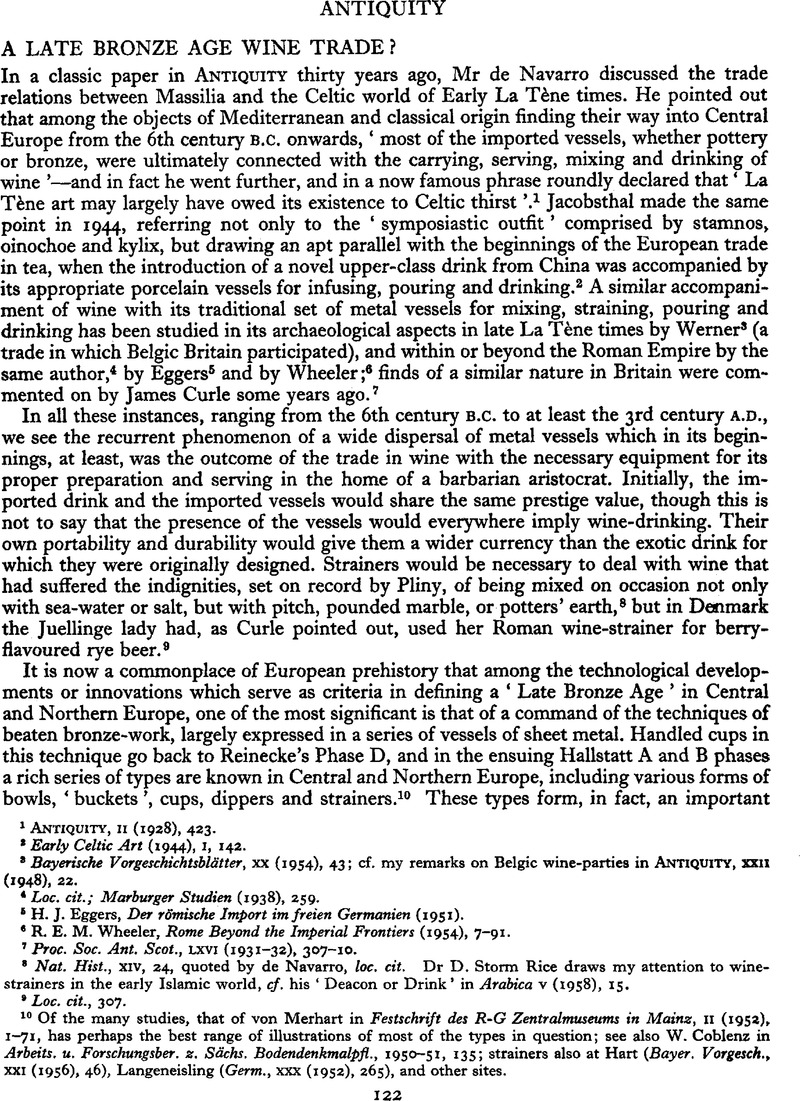Article contents
A LATE BRONZE AGE WINE TRADE?
Published online by Cambridge University Press: 26 May 2015
Abstract

- Type
- Notes and News
- Information
- Copyright
- Copyright © Antiquity Publications Ltd 1959
References
1 ANTIQUITY, II (1928), 423.
2 Early Celtic Art (1944), 1, 142.
3 Bayerische Vorgeschichtsblätter, xx (1954), 43; cf. my remarks on Belgic wine-parties in ANTIQUITY, XXH (1948), 22.
4 Loc. cit.; Marburger Studien (1938), 259.
5 Eggers, H.J., Der römische Import im freien Germanien (1951).Google Scholar
6 Wheeler, R.E.M., Rome Beyond the Imperial Frontiers (1954), 7–91.Google Scholar
7 Proc. Soc. Ant. Scot., LXVI (1931–32), 307–10.
8 Nat. Hist., XIV, 24, quoted by de Navarro, loc. cit. Dr D. Storm Rice draws my attention to wine-strainers in the early Islamic world, cf. his ‘Deacon or Drink’ in Arabica v (1958), 15.
9 Loc. cit., 307.
10 Of the many studies, that of von Merhart, in Festschrift des R-G Zentralmuseums in Mainz, 2 (1952), 1–71,Google Scholar has perhaps the best range of illustrations of most of the types in question; see also Coblenz, W. in Arbeits. u. Forschungsber. z. Sächs. Bodendenkmalpfl., 1950–51, 135 Google Scholar; strainers also at Hart, (Bayer. Vorgesch., 21 (1956), 46),Google Scholar Langeneisling, (Germ., 30 (1952), 265), and other sites.Google Scholar
11 Antiq.Journ., XXXVII (1957), 131.
12 Von Merhart, loc. cit. and in other studies; Childe, in Acta Arch., 20 (1949), 257.Google Scholar
13 Cf. Jacobsthal, op. cit. 137 on ‘ stamnos-situla ’ vessels.
14 Proc. Prehist. Soc. xiv (1948), 189.
15 Acta Arch., loc. cit.
16 Ann. Brit. School Athens, LI (1958), 88.
17 Cups in the Dresden-Dobritz find (of cups, bowls, strainer and small ‘ bucket ’) were certainly so finished, and further evidence (with unfinished examples) comes from Riesa-Gröba in the same region (Coblenz, loc. cit., and technical appendix by A. Pietszch). The characteristic central indentation made by the pin of the lathe chuck within the omphalos which these examples show appears also on the Knossos gold cup already mentioned, the ‘ Octopus ’ gold cup from Dendra, and probably also the Enkomi silver cup, referred to by Hood, loc. cit. 87. The technique is, of course, well-known in much later contexts (cf. Ulster Journ. Arch., XX (1957), 85). I hope to discuss this matter more fully on another occasion.
18 Ventris, M. and Chadwick, J., Docs, in Myc. Greek (1956), 130,Google Scholar arguing (partly on absence of strainers I) against Evans’s case for beer-drinking Minoans.
- 5
- Cited by


